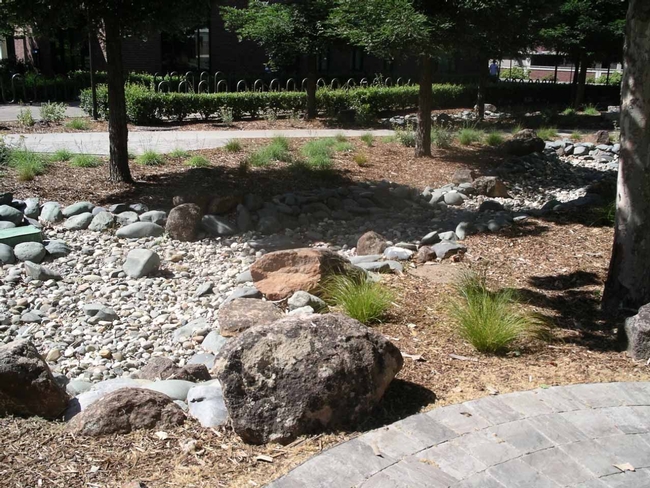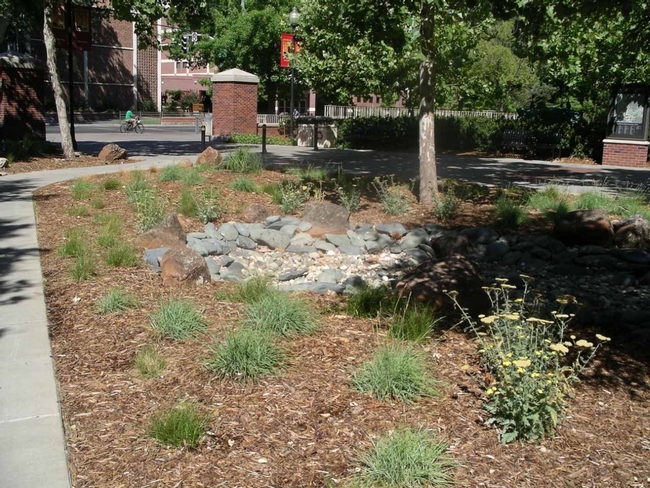By Cindy Weiner, Butte County Master Gardener, September 9, 2016.

The bioswale on the campus of California State University, Chico collects rain water from the roof and grounds of the Student Services Center (SSC) as well as runoff from the south side of Meriam Library, the west side of Bell Memorial Union and the large plaza connecting the three buildings. When the SSC building was completed in 2008, the bioswale was one of the landscape elements required in order for it to receive silver certification from LEED (Leadership in Energy and Environmental Design).
Rainwater collected from the SSC is first drained into an underground cistern, where dirt and other particulates sink to the bottom. When the cistern is full, the water is pumped through a pipe into the bioswale. Runoff water from the plaza drains directly to the bioswale. As the runoff moves downslope through the bioswale, it slows down, allowing some water to infiltrate into the ground and the rest to slowly make its way into the campus storm drain system. Slowing down the runoff helps to keep the storm drains from flooding. The vegetation filters out some of the impurities in the water. Infiltration reduces the amount of water flowing into storm drains and helps recharge ground water. In some localities the native soil must be modified in order to increase the soil's capacity to accept so much water without flooding. The native soil on the Chico campus, however, has excellent drainage and did not require any further engineering.

The bioswale was remodeled in 2015 to make it more attractive and to provide a pleasant place for sitting and strolling without compromising its function. This remodel is the first major project on campus to be completely designed and installed by the Facilities Management Ground and Landscape Services Department. A dry creek bed of boulders and rocks was installed to reduce irrigation needs in the summer, and a walking path meanders the length of the bioswale. New vegetation includes two species of sedges that will spread by underground rhizomes to fill the space and a variety of native and non-native perennials and small shrubs to provide pops of color. The sedges are especially valuable in their ability to filter the water and are planted in the lower parts of the swale. The more colorful plants include yarrow, sticky monkeyflower, Matilija poppy, and Texas sage. Existing sycamore and redwood trees cast filtered shade that makes the area pleasant even in the summer heat. A bench formed from large blocks of Tuscan mudflow unearthed during a local residential construction project is an attractive place to sit and look at the plaza and its activities. Educational signage explaining the bioswale, plantings and Tuscan mudflow should be installed soon.
Bioswales are designed to handle large amounts of runoff in commercial or institutional settings. But home gardeners can make a rain garden to provide a similar function in their yards. Rain water from downspouts or runoff from hardscaped areas can be directed to an area where the water is slowed, collected, filtered and infiltrated into the ground. This would typically be an area that is lower than surrounding areas and landscaped with a variety of plants that can withstand periodic flooding during the rainy period. Soil drainage can be improved by adding compost or other organic material.